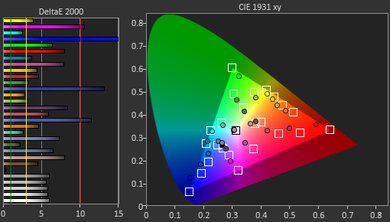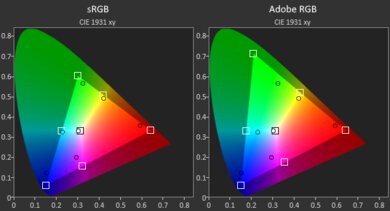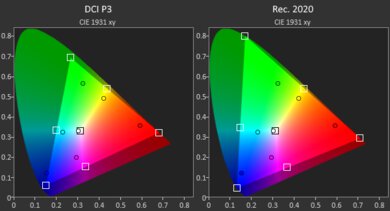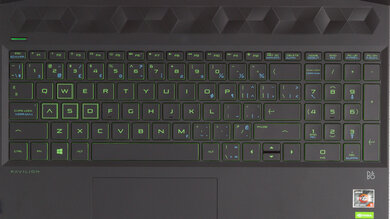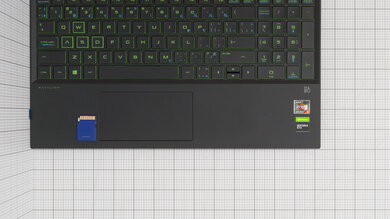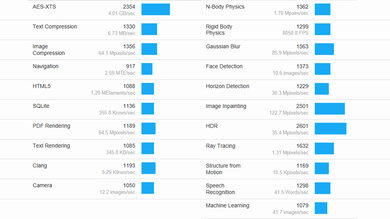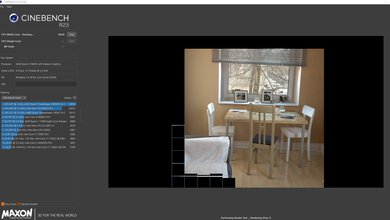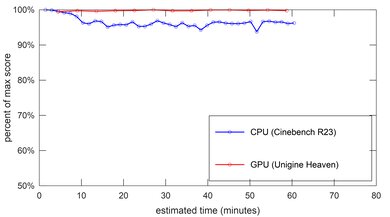The HP Pavilion Gaming Laptop 15 (2021) is an entry-level gaming laptop that's available with AMD Ryzen 5000-series CPUs and dedicated NVIDIA GPUs. It's made entirely of plastic, yet it feels well built and solid. It's also very easy to access the internals if you need to upgrade the RAM or add a 2.5 inch hard drive. The user experience is decent overall: the keys on the keyboard are well spaced and have a good amount of travel, and there's a Numpad if you often do calculations or work in spreadsheets. Its touchpad tracks movements well, although it has some trouble with multi-touch gestures. There's a decent selection of ports, including a dedicated HDMI 2.0 port and three total USB ports to connect all your peripherals, but its single USB-C port only supports data transfer and video output, so you can't use it to charge the laptop. Unfortunately, the screen looks washed out due to its narrow color gamut, and it doesn't get bright enough for use outdoors or in bright rooms. Also, it has poor battery life and can't get through a full workday, and it gets noticeably hot and very loud under load. You'll likely need a dedicated microphone for video conferences as the built-in microphone records muffled, nasally audio.
We tested the Pavilion Gaming Laptop with a 1080p 60Hz display, an AMD Ryzen 5 5600H, a dedicated NVIDIA GeForce GTX 1650 GPU, 8GB of RAM, and a 512GB SSD. The Ryzen 5 5600H is more than enough for most modern AAA titles and heavy creative workloads, but you can get the more powerful Ryzen 7 5800H if you need more cores and threads for applications like physics simulations or video editing. If you want features like ray-tracing or DLSS upscaling in your games, we suggest you opt for the RTX 3050 or 3050Ti as the 1650 doesn't support either of them. Finally, you can upgrade to a 144Hz display for more fluid movement, which can improve aim in FPS games and potentially improve cursor precision in MOBAs.
Our Verdict
The HP Pavilion Gaming Laptop is adequate for school use. It has a well-built, solid chassis, a very good keyboard that doesn't feel tiring to type on over time, and a touchpad that tracks movements well. Additionally, it's available with amazingly fast AMD CPUs and dedicated NVIDIA GPUs, great for students who edit video or work with 3D renders. Unfortunately, it's on the bulkier and heavier side, making it a little difficult to carry around everywhere. Also, its battery lasts only a little over six hours of light productivity, so you'll also need to bring its dedicated barrel-plug charger since you can't charge via USB-C. Its screen doesn't get bright enough for comfortable use outdoors, and its microphone records bad-sounding audio.
- Good, sturdy-feeling build.
- Fast AMD CPUs and powerful NVIDIA dedicated graphics.
- Keyboard doesn't cause fatigue over extended periods.
- Numpad makes it easier to do calculations or work in spreadsheets.
- Battery lasts only a little over six hours of light productivity.
- A little too bulky and heavy to bring everywhere.
- Need to bring dedicated power adapter since there's no support for USB-C charging.
- Webcam loses fine details, and microphone sounds bad.
The HP Pavilion Gaming Laptop is decent for playing games. Its H-series AMD Ryzen CPUs and dedicated NVIDIA GPUs run modern AAA games decently well, although you'll need to opt for the more powerful RTX 3050 or 3050Ti GPUs if you want smoother gameplay at maximum graphical settings. It barely throttles, meaning you can play at maximum performance for extended periods. The port selection should be enough for all your peripherals, including a dedicated HDMI 2.0 port to output to an external display. Additionally, you can upgrade the RAM and 2.5 inch storage drive. Unfortunately, it gets hot and loud under load. You can opt for a 144Hz display if you prefer a smoother experience.
- Fast AMD CPUs and powerful NVIDIA dedicated graphics.
- Very little throttling over time.
- Upgradeable RAM and 2.5 inch drive slot.
- GTX 1650 isn't power enough to run AAA games smoothly at max settings.
- Gets hot and loud under load.
The HP Pavilion Gaming Laptop is mediocre for multimedia use. While its 15 inch 1080p monitor looks decently sharp, it looks washed out and doesn't get very bright. This means it can't provide a satisfactory HDR viewing experience, and it also isn't suitable for use in very brightly lit rooms as it can't fully overcome glare. It can barely get through a single full-length film on battery power, so you'll need to keep it plugged in if you expect to binge a TV series. Additionally, its speakers don't get very loud and are heavy in the low treble, so content might not sound as rich.
- IPS panel has a decent contrast ratio.
- Virtually silent when idle or under light workloads.
- Screen looks washed out and doesn't get bright enough to overcome glare.
- Battery barely lasts through a single full-length film.
- Speakers don't get very loud.
The HP Pavilion Gaming Laptop is great for workstation use. It scores amazingly well in benchmarks and is very well suited for running 3D rendering tasks, making it a compelling option for people who work in 3D modeling or animation. Additionally, there's very little throttling over time, so the laptop stays near its full performance during extended rendering or computational workloads. You can opt for the more powerful Ryzen 7 5800H if you need more CPU power for highly threaded tasks, while the higher-end RTX 3050 and 3050Ti will provide a sizable boost in ray-traced renders and neural network dataset training.
- Fast AMD CPUs and powerful NVIDIA dedicated graphics.
- Very little throttling over time.
- Upgradeable RAM and 2.5 inch drive slot.
- Remarkably fast SSD.
- Gets hot and loud under load.
The HP Pavilion Gaming Laptop is satisfactory for business use. It feels well built despite its entirely plastic chassis, and you can get it with optional white backlighting if the green accents are too much for you. Its keyboard keys are well spaced and don't cause fatigue when typing over extended periods, and there's a Numpad for easy number input if you work frequently in spreadsheets. There's a decent port selection, enough to output to an external display and hook up some wired peripherals, and it provides more than enough performance for even the heaviest multitaskers. Unfortunately, it isn't very portable, and its battery can't last through a full workday. Also, the webcam loses most fine details, and the built-in microphone records muffled, nasally audio, so it isn't optimal for video conferences.
- Good, sturdy-feeling build.
- Keyboard doesn't cause fatigue over extended periods.
- Numpad makes it easier to do calculations or work in spreadsheets.
- RAM and storage are serviceable.
- Battery lasts only a little over six hours of light productivity.
- A little too bulky and heavy to bring everywhere.
- Screen looks washed out and doesn't get bright enough to overcome glare.
- Webcam loses fine details, and microphone sounds bad.
Changelog
- Updated Feb 29, 2024: Added mention of the Lenovo LOQ 15 (2023) as an alternative available with NVIDIA 40-series GPUs in the GPU section.
- Updated Feb 08, 2022: Review published.
- Updated Jan 31, 2022: Early access published.
- Updated Jan 18, 2022: Our testers have started testing this product.
Check Price
Differences Between Sizes And Variants
We tested the HP Pavilion Gaming Laptop 15 (model 15-ec2008ca) with an AMD Ryzen 5 5600H CPU, an NVIDIA GeForce GTX 1650 dedicated GPU, 8GB of RAM, and a 512GB SSD, in the Shadow Black color scheme with Acid Green backlighting. All the components are configurable; see the table below for all the options. Keep in mind that most vendors, including HP, sell laptops as pre-built models with pre-determined configurations instead of letting customers choose the parts individually. As a result, it may be hard to find the exact configuration you want.
There are other models of the HP Pavilion 15 Gaming that use different port layouts and Intel CPUs, so to avoid confusion, our review only applies to the 15-ec2000 series.
| Screen |
|
|---|---|
| CPU |
|
| GPU |
|
| RAM |
|
| Storage |
|
| Color |
|
Our display and performance results are only valid for the configuration we tested. If you come across a different configuration option not listed above, or you have a similar HP Pavilion Gaming Laptop that doesn't correspond to our review, let us know, and we'll update it. Some tests, like black uniformity and color accuracy, may vary between individual units.
You can see our unit's label here.
Popular Laptop Comparisons
The HP Pavilion Gaming Laptop is an entry-level gaming laptop that performs about the same as other laptops in its class. It's available with H-series AMD Ryzen CPUs and mid-range NVIDIA dedicated GPUs that provide good framerates in most AAA games at 1080p, with only a few tweaks to the graphical settings. It also performs very well for creative tasks like 3D renders and video editing. Unfortunately, its speakers don't get very loud, it suffers from poor battery life, and it gets very hot and loud under load.
The HP Pavilion Gaming Laptop 15 (2021) and the Acer Nitro 5 15 (2020) are both entry-level gaming laptops that perform about the same when playing games. The HP is available with newer AMD Ryzen 5000-series Ryzen CPUs, which provide slightly better performance compared to the Ryzen 4000-series CPUs on the Acer; however, newer versions of the Nitro 5 are available. The HP is better as a workstation as you can get it with either an NVIDIA RTX 3050 or 3050Ti dedicated GPU, both of which provide a better experience in 3D rendering and computational workloads compared to the GTX 1650 or 1650Ti on the Acer. On the other hand, the Acer is better for school and multimedia use thanks to its significantly longer battery life, better-quality microphone, much brighter screen, and louder, better-sounding speakers. Unfortunately, the Acer's keyboard sometimes doesn't register some keystrokes, which could be frustrating during competitive gaming matches.
The Lenovo Legion 5 Gen 6 15 (2021) is better than the HP Pavilion Gaming Laptop 15 (2021). The Lenovo has a sturdier build, a better keyboard, and a wider port selection. The configuration options are similar between the two laptops, but the Lenovo has a QHD display option, as well as higher-end GPUs like an NVIDIA GeForce RTX 3070 and AMD Radeon RX 6600M. The Lenovo laptop also has a MUX switch, which the HP laptop lacks.
The HP Pavilion Gaming Laptop 15 (2021) and the Apple MacBook Pro 16 (M1, 2021) are two very different laptops. The MacBook runs macOS and is designed for use as a creative workstation, and even though its M1 Pro or Max chip performs well in some games, it's far superior in video editing and 3D renders thanks to its significantly faster threaded performance, much larger unified memory, and dedicated video encoders and decoders. Additionally, the MacBook provides a far superior user experience thanks to its significantly brighter, more color-accurate, better-looking display, and it has a better-feeling keyboard, a larger, better-tracking touchpad, and louder, bassier speakers. On the other hand, the HP runs Windows and is designed for gaming, with a choice of entry-level dedicated NVIDIA GPUs and fast H-series AMD Ryzen CPUs that perform decently in most games. Unfortunately, like most gaming laptops, the HP's battery is much worse than the MacBook's.
The HP Pavilion Gaming Laptop 15 (2020) and the HP Pavilion x360 14 (2021) are both Windows laptops that are part of HP's Pavilion lineup. The x360 is better for school and multimedia use because its battery lasts much longer, it's significantly more portable, and you can use its 360-degree hinge to fold the laptop into tablet mode. The x360's microphone records better-sounding audio, it runs much cooler and quieter, its speakers get much louder, and its USB-C port supports charging the laptop. On the other hand, the Pavilion Gaming is much better suited for gaming and as a workstation, as it's available with powerful AMD Ryzen H-series CPUs and dedicated NVIDIA GPUs. Additionally, its keyboard and touchpad feel better to use.
Test Results

The HP Pavilion Gaming Laptop has a gamer-oriented aesthetic. The chassis and outer shell are made of matte black plastic, with an angular design, a geometric speaker grill, and large rear vents. The keyboard has green backlighting, which HP calls "Acid Green" accenting, and the keycap legends have a very gamer-oriented style. There's also a green-tinted chrome HP logo on the outer shell behind the screen. You can get the laptop with "Ghost White" backlighting and accents.
The HP Pavilion Gaming Laptop has good build quality. It's made entirely of plastic yet feels solid and is relatively scratch-resistant. There's some flex on the keyboard deck and the back shell, and the screen also flexes when twisted; however, the laptop still feels very solid overall when it's closed. It has rubber feet that help keep the laptop stable when placed on a flat surface.
The HP Pavilion Gaming Laptop has an outstanding hinge. It feels smooth and exudes a "high-quality" feel when opening and closing it, and it keeps the screen steady in its set position. However, the screen wobbles a bit when you type aggressively or on an uneven surface.
The HP Pavilion Gaming Notebook's portability is only okay, as expected of a gaming laptop. It's noticeably bulky and heavy, and its charger is a bit large, so you'll likely need to use a larger laptop bag if you want to take the laptop and its charger around. If you want a more portable gaming laptop, check out the ASUS ROG Zephyrus G14 (2022).
The HP Pavilion Gaming Laptop has impressive serviceability. It's easy to disassemble, requiring you only to unscrew two different sizes of Phillips head screws before prying the panel open with a thin item like a guitar pick. It's easy to replace the network card, battery, and both RAM modules, as well as to add or upgrade the 2.5 inch drive. Opening the laptop and changing to the hardware may void the manufacturer's warranty.
The HP Pavilion Gaming Laptop is available only with a 15 inch 1080p IPS screen. Its decent pixel density means that text and videos look relatively sharp, so you can view documents or webpages without needing to zoom in. The top and side bezels are very thin and likely won't distract you when playing games or watching media, although the bottom chin is very thick.
The HP Pavilion Gaming Laptop is available with either a 60Hz or a 144Hz refresh rate panel. Our model with the 60Hz panel has a noticeably slow response time, resulting in visible ghosting behind moving objects. The 144Hz option will perform significantly better and is a much better choice if you intend to game competitively or view fast-moving content like sports. You'll likely need to lower the graphical settings in more demanding games to appreciate the higher refresh rate.
The HP Pavilion Gaming Laptop with the 250cd/m²-advertised panel has a sub-par maximum brightness. It doesn't get bright enough to overcome glare in brightly lit rooms, let alone when working outdoors. However, it gets dim enough at its lowest brightness setting to provide a comfortable dark room viewing experience. There are variants with a brighter, 300cd/m²-advertised panel which we expect to perform better in bright rooms but still not good enough for use outdoors.
The HP Pavilion Gaming Laptop has good reflection handling. Its matte screen helps disperse reflections, so although sources like bright lights are still visible with the screen at maximum brightness, they aren't too distracting. However, you'll still get a noticeable amount of indirect glare in very bright surroundings that could make content difficult to see.
The HP Pavilion Gaming Laptop's black uniformity is just alright. There's a bit of backlight bleed and clouding in some parts of the screen, although keep in mind that they're only visible when viewing dark scenes in a dark room. Black uniformity may vary between units.
The HP Pavilion Gaming Laptop has mediocre horizontal viewing angles. The image stays relatively accurate as long as you're looking at it from more or less straight on, but it dims and washes out dramatically the further off center you go. It isn't very good for sharing content with people beside you.
The HP Pavilion Gaming Laptop has unremarkable vertical viewing angles. Again, the image remains accurate so long as the screen is tilted relatively straight towards you, but it quickly becomes dimmer and washed out the further away you tilt it. You only have a small amount of leeway to tilt the screen to your preference, which can impact how and where you can comfortably use the laptop if image accuracy is important to you.
The HP Pavilion Gaming Laptop has poor color accuracy out of the box. Most colors are inaccurate because of the display's very narrow color gamut, and the white balance is noticeably off. The color temperature is cooler than our 6500K target, making the image appear a bit bluer than it should. The gamma more or less follows a flat 2.0, so most scenes look brighter than they should; this can make most movie and TV show scenes look washed out, but it might aid in competitive gaming where darker shapes are usually more difficult to make out. Color accuracy may vary between units.
The HP Pavilion Gaming Laptop has a very narrow color gamut. It doesn't have full sRGB coverage, so it can't properly display all the colors commonly used online. As a result, most content looks washed out. Consequently, it has bad coverage of the wider Adobe RGB, DCI P3, and Rec. 2020 gamuts, meaning it isn't a good choice for professional photo or video editors, nor can it provide a satisfactory HDR experience.
The HP Pavilion Gaming Laptop has a very good keyboard. It feels good to type on, with adequately stable keys made of fair-quality plastic. It also doesn't cause fatigue over extended periods thanks to its long travel distance and moderate tactile bump. The keys are well-spaced, but you might need to get used to the unusual layout of the arrow keys and some special function keys. There's a Numpad, which can be helpful if you need to bind extra keys in some games or if you often enter numbers in spreadsheets. Some variants, including ours, have backlighting with adjustable brightness, but you can't change the color, so it's limited to Acid Green or Ghost White. You can get it without backlighting if that isn't important to you.
The HP Pavilion Gaming Laptop has a decent touchpad. It's on the smaller side, but it tracks movements accurately without any stutters. However, it occasionally has issues with multi-touch gestures, meaning that you might occasionally have trouble drag-selecting multiple icons or items in a list. Because there's a Numpad, the touchpad is shifted towards the left side of the keyboard deck to keep it centered under the main part of the keyboard, which some people might not like. If you want a similar budget gaming laptop with a larger and more responsive touchpad, check out the Lenovo IdeaPad Gaming 3 (2021).
The HP Pavilion Gaming Laptop's speakers are only alright. They fire upwards from above the keyboard, close to the screen, and have very little compression at maximum volume. That said, they don't get very loud, so they aren't a good choice for immersive listening when watching movies or playing games. The frequency response is mid- and treble-heavy, with a small bump in the low-treble to emphasize vocals. This means the speakers provide a satisfactory listening experience in speech-heavy content like podcasts, but varied content doesn't sound very rich. If you want a gaming laptop with better speakers, check out the HP Victus 16 (2021).
The HP Pavilion Gaming Laptop has an adequate webcam and microphone. The webcam image is slightly overexposed and loses some fine details due to noise. It's also significantly cropped, resulting in a narrow field of view. Fortunately, colors look natural overall. On the other hand, the microphone records muffled, bad-sounding audio, and voices sound nasal.
The HP Pavilion Gaming 15 has a decent port selection. There are two USB-A ports, one on each side; the one on the right supports the USB 3.2 Gen 1 data transfer protocol (up to 5Gbps), while the one on the left supports USB 2.0 (up to 480Mbps) and HP Sleep and Charge, which allows you to charge devices more quickly even when the laptop is in sleep mode. The USB-C port supports USB 3.2 Gen 1 and video output, but you can't use it to charge the laptop. Fortunately, there's an HDMI 2.0 port if you need to output to an external monitor.
The HP Pavilion Gaming 15 uses a Realtek RTL8852AE (2x2) wireless adapter. Some models use a Realtek RTL8852AE (1x2) wireless adapter, which has half the theoretical maximum upload speed; however, we don't expect there to be a noticeable difference in real-world workloads unless you expect to be uploading lots of data at a time, like when streaming gameplay to Twitch or YouTube. Some variants use an Intel Wi-Fi 6 AX200 (2x2).
The HP Pavilion Gaming is available with the AMD Ryzen 5 5600H 6-core CPU or the AMD Ryzen 7 5800H 8-core CPU. The 5600H has a maximum boost frequency of 4.2GHz, whereas the 5800H goes up to 4.4GHz, which isn't enough to make much of a difference in single-thread performance. Both CPUs are more than capable of handling web browsing and light productivity tasks like word processing and are suitable for CPU-heavy loads like open-world games and physics simulations. By upgrading to the Ryzen 7 5800H, you'll benefit most from gains in multi-thread performance thanks to the two extra cores and four extra threads. As a result, you'll have a smoother experience during heavy multitasking loads and in highly threaded tasks like video editing.
You can get the HP Pavilion Gaming with the NVIDIA GeForce GTX 1650, RTX 3050, or RTX 3050Ti. They're all entry-level dedicated GPUs capable of running most AAA games at good framerates in 1080p, with only a few tweaks to the graphical settings. They all have 4GB of dedicated VRAM, which is enough to seamlessly display medium-complex scenes in 3D rendering applications like Blender. However, we don't expect it to be enough to smoothly play large, open-world video games at the highest graphical settings. We strongly recommend you avoid variants without a dedicated GPU as it'll severely limit the games you can play. Additionally, if you want to take advantage of the 144Hz refresh rate panel, we suggest you opt for the better-performing RTX 3050 or 3050Ti to squeeze out as many frames as possible. If you want a similar budget gaming laptop with more powerful GPU options, check out the Dell G15 (2022).
Only the RTX 3050 and 3050Ti have ray tracing (RT) and tensor cores, which enable the use of ray tracing and NVIDIA DLSS (Deep Learning Super Sampling) in some games. It probably isn't worth turning on ray tracing features as it results in a very big performance hit, especially for entry-level GPUs like the 3050 and 3050Ti. On the other hand, enabling DLSS in supported games boosts frame rate dramatically while retaining a good amount of graphical fidelity, allowing you to enjoy smoother gameplay even with the graphical settings turned up. If you want a gaming laptop available with NVIDIA 40-series GPUs, which support Frame Generation, check out the Lenovo LOQ 15 (2023).
The user manual specifies that this laptop model supports NVIDIA Optimus. However, upon comparing the results of our battery life tests and Basemark GPU benchmarks with the similarly equipped Acer Nitro 5 15 (2020), there doesn't seem to be a noticeable bottleneck in GPU performance, nor is there improved battery life. As a result, we conclude that Optimus technology isn't available with this model.
The HP Pavilion Gaming is available with 8, 12, or 16GB of RAM. 8GB is more than enough to run light productivity applications and for moderate multitasking, but gamers should opt for at least 12GB to be able to run more demanding games.
The HP Pavilion Gaming 15 is available with a 256GB, 512GB, or 1TB M.2 PCIe NVMe SSD. Some variants have a much slower 1TB 7200RPM HDD paired with a 256GB M.2 PCIe NVMe SSD, which could be a better choice if you want extra space for storing documents but don't need very much high-speed storage for commonly used applications or files.
The HP Pavilion Gaming Laptop with the AMD Ryzen 5 5600H has amazing performance in Geekbench. Its single-thread performance is outstanding, better than that of the Intel Core i7-10750H in the Dell Alienware m15 R3 (2020) that we tested, meaning its performance in applications like photo editing is superb. Its excellent multi-thread performance means it's very smooth when running most modern applications and when multitasking, and is a great choice for playing complex games and running applications like video editors. Its GeForce GTX 1650 performs well in the GPU compute benchmark, meaning it's a good choice if you want to run complex simulations or perform computations on large sets of data.
The higher-end options of the HP Pavilion Gaming Laptop with the AMD Ryzen 7 5800H won't have noticeably better single-thread performance because the CPU's core clock speed isn't much faster than the Ryzen 5 5600H. However, because the Ryzen 7 has more cores and threads, it'll be better for heavy multitaskers or people who need lots of CPU performance from their laptop. The RTX 3050 and 3050Ti will deliver noticeably improved GPU compute scores, and they'll also be better for deep learning and AI programs thanks to their additional tensor cores.
The HP Pavilion Gaming Laptop with the AMD Ryzen 5 5600H has superb performance when rendering in Cinebench. It's a good choice for professionals in 3D rendering who work on a deadline. The AMD Ryzen 7 5800H will perform noticeably better thanks to its greater number of cores and threads, allowing it to render even more portions of the scene at a time.
The HP Pavilion Gaming Laptop has great performance in Blender. The AMD Ryzen 5 5600H renders the bmw27 scene very quickly, on par with the M1 Max–powered Apple MacBook Pro 16 (2021) in our tests, making it a compelling option for people who work with high-fidelity 3D renders. We expect the AMD Ryzen 7 5800H to render the same scene in a little over three and a half minutes. The NVIDIA GeForce GTX 1650 renders the scene much faster than the CPU, so it's an excellent choice if you mainly use a GPU for rendering workloads.
Variants of the HP Pavilion Gaming Laptop with the RTX 3050 and 3050Ti will render similar scenes noticeably faster. However, they have additional RT cores, so you can use the OptiX API to significantly reduce rendering times in scenes with ray-traced lighting.
The HP Pavilion Gaming Laptop scores decently in the Basemark GPU benchmark. It'll perform well overall for most games, but we expect you'll need to lower most graphical settings to achieve smooth gameplay in newer AAA titles. The RTX 3050 and 3050Ti will provide noticeably smoother gameplay, allowing you to turn up your graphical settings a bit more while keeping framerates high.
The HP Pavilion Gaming Laptop's 512GB M.2 PCIe NVMe SSD has outstanding performance. Its remarkably fast read speeds mean the laptop will boot up, launch applications, and load large files very quickly, while its superb random write speed means that installing applications and copying over many small files will take no time at all. Its sequential write speed is comparatively lower, meaning that copying over large files feels a bit slower than other tasks, but the laptop still feels snappy overall. The speed of the SSD may vary depending on the size, as larger SSDs tend to perform better.
Variants of the HP Pavilion Gaming Laptop with the SSD + HDD combo will perform differently depending on which drive you're reading data from or putting data into. For the best experience, we suggest that you store games that are smaller, older, or less often played into the slower HDD, while your most-played games, or those that take the longest to load, are better off on the faster SSD. Also, downloading or transferring critical files to the laptop will be much faster if you use the SSD directly.
The HP Pavilion Gaming Laptop has poor battery life. It doesn't last through a full 8-hour day, so you'll need to bring the dedicated barrel-plug charger to keep it topped up at work since it can't charge via USB-C. It can barely playback a full-length movie before dying, so it isn't the best option for watching Netflix while unplugged. It lasts only a little more than an hour while gaming, but this is expected of a laptop with a dedicated GPU. We expect variants with the more powerful AMD Ryzen 7 5800H CPU and/or NVIDIA RTX 3050 and 3050Ti GPUs to run out noticeably faster under load. Battery life varies greatly depending on usage.
The HP Pavilion Gaming model that we tested has disappointing performance in Borderlands 3 at High settings. It provides a barely playable experience, with an average FPS in the mid-30s, and there are noticeable, occasional stutters that could be frustrating if you're in the middle of an intense firefight. That said, you can achieve higher framerates and smoother gameplay by lowering the graphical settings. You'll get better framerates if you opt for the RTX 3050 and 3050Ti, but we don't expect the gaming experience to improve noticeably if you only upgrade the CPU to the Ryzen 7 5800H.
The HP Pavilion Gaming model that we tested runs Civilization VI decently well, providing a smooth gaming experience. There are almost no stutters during normal gameplay, although the framerate lowers when panning around the game world. The turn time with the AMD Ryzen 5 5600H is decent, but we expect the Ryzen 7 5800H to provide faster turn times, especially in larger games, thanks to its increased core and thread count. The RTX 3050 and 3050Ti will run the game more smoothly overall.
The HP Pavilion Gaming model that we tested runs CS:GO remarkably well, with only small stutters here and there. Variants with the 144Hz panel are a viable option for competitive gamers as the laptop can easily run the game above its native refresh rate. We expect the Ryzen 7 5800H to provide a somewhat smoother gaming experience, although the difference might not be noticeable. If you expect to output to an even higher refresh rate external monitor and want even more frames, especially on higher graphical settings, we suggest you opt for the RTX 3050 or 3050Ti.
The HP Pavilion Gaming model we tested has decent performance in Shadow of the Tomb Raider. The gameplay is smooth even at "High" settings, although you'll need to lower a few graphical settings to reach 60FPS. There are a few stutters here and there, but it isn't bad enough to severely take away from a satisfactory gaming experience. We don't expect the Ryzen 7 5800H to run the game much better, as the game is heavily GPU dependent; on the other hand, the RTX 3050 and 3050Ti will provide noticeably better framerates, and the game will run even better if you also enable DLSS.
The HP Pavilion Gaming Laptop has mediocre thermal and noise handling. The keyboard deck already gets noticeably warm when the laptop is idle, and it becomes very hot on the right side around the Enter key under load. The fans emit a loud whooshing sound with a bit of whine when the laptop runs heavy loads, so you'll need to wear headphones for a good gaming experience. On the bright side, it's virtually silent when it's idle, so you can confidently use it in noise-sensitive environments in classrooms if you only need to run light productivity tasks. If you want a gaming laptop that doesn't get as hot or loud under load, check out the Lenovo IdeaPad Gaming 3i (2021).
The included HP CoolSense software automatically adjusts the fan settings to improve user comfort when the laptop is in a stationary position.
The HP Pavilion Gaming Laptop that we tested has superb performance retention under load. The GPU virtually doesn't throttle, so graphical performance stays at its best even if you've been gaming at full tilt for a while. However, it's difficult to say how well variants with the NVIDIA RTX 3050 and RTX 3050Ti will retain maximum performance before throttling. On the other hand, the CPU gets quite hot and throttles a little bit, so the higher-end Ryzen 7 5800H will likely throttle a bit more because of its higher core and thread count.
The HP Pavilion Gaming Laptop runs Windows 11, the successor to Windows 10 with a simplified interface and design. It comes with lots of pre-installed applications, including:
- B&O Audio Control: Lets you customize different options for the built-in speakers.
- Booking.com: App for the travel booking website.
- Disney+: App for Disney's streaming service.
- Dropbox: App for the cloud storage service.
- Express VPN: App for the VPN service.
- HP Audio Switch: Audio control panel for HP laptops.
- HP CoolSense: Automatic fan control utility to help keep the laptop cool or quiet, depending on the workload and surrounding environment.
- HP Documentation: Contains warranty information, regulatory, safety, and environmental notices, and the user guide.
- HP PC Hardware Diagnostics Windows: Self-diagnostic program to detect issues with the laptop's hardware or software.
- HP Privacy Settings: Lets you choose the type of information you share with HP.
- HP QuickDrop: Lets you transfer files wirelessly between your PC and mobile devices.
- HP Smart: Companion app for HP printers.
- HP Support Assistant: Helps with system updates and troubleshooting of common issues. Connects you to an HP Virtual Agent for further troubleshooting.
- HP System Event Utility: Lets you program special function keys or shortcuts, like turning the wireless on or off, and adjusting the screen brightness.
- LastPass: Password manager service.
- McAfee Personal Security: Anti-malware application.
- Minecraft Education Edition: Special edition of Minecraft designed for classroom use.
- myHP: Online store for HP products.
- Spotify: App for the music streaming service.
- WildTangent Games: App store for hidden object games, time management games, and matching games, among others.





















